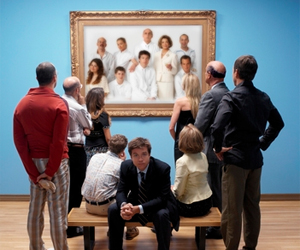 Cancellation is almost always a death sentence for a television show. Some are revived decades later, like the 80’s soap opera Dallas, which was reborn with a handful of original cast members this past June, but most live in our hearts, minds, and in DVD box sets.
Cancellation is almost always a death sentence for a television show. Some are revived decades later, like the 80’s soap opera Dallas, which was reborn with a handful of original cast members this past June, but most live in our hearts, minds, and in DVD box sets.
Arrested Development, which was cancelled in 2006, has cheated death. In a brilliant and telling move, Netflix, an on-demand and streaming media provider, has breathed new life in the show by signing it on for a new season to air exclusively on the company’s service. With a subscription, Arrested Development fans will be able to watch the entire new fourth season (ten episodes), which will be released all at once in 2013. Netflix also offers the first three seasons for those who can’t get enough of the Bluth family—a smart move to hook old fans again, by revisiting their favorite episodes.
This unprecedented move gives us a glimpse into what the future of television programming might hold. Are we at a place where consumers can escape the iron fist of cable and satellite TV providers and watch what they want, when they want, for a fraction of the cost? We’ve already peeked into the future of automobile advertising. What’s in store for our entertainment needs? Will on-demand and streaming services beat out the old guard of cable and satellite?
“You Still Pay for Cable?”
In a world where on-demand media is quickly sneaking up on the cable and satellite TV industry, Netflix has taken a giant leap toward the video entertainment paradigm of the future: television served up exclusively on demand.
Just as MP3s have changed how we buy and consume music, it’s becoming easier and easier for audiences to watch their favorite shows at a fraction of the cost of cable or satellite television. In the same way that CD stores have all but disappeared to make way for iTunes, Spotify, Pandora and the like, isn’t it inevitable that cable and satellite TV will disappear as well? Should cable and satellite providers start to worry?
Peering into the Now
I’m not looking into a crystal ball. The technology to ditch cable and still be able to watch endless amounts of programming is already here. Early adopters have embraced streaming and downloadable media all the way to the bank.
Services like iTunes, Netflix, HuluPlus and Amazon Instant Video have provided consumers with movies and TV series at their fingertips. Netflix and HuluPlus are subscription-based, both priced at $7.99 per month for unlimited access to movies, current and past TV shows and original programming. iTunes and Amazon offer instant downloads of individual movies and TV show episodes, as well as subscriptions to full show seasons.
All of these services are available on the web, but most are also available on tablets and smartphones, plus a variety of other Internet connected TVs, Blu-ray DVD players and gaming systems, which allow consumers to watch the programming right on their TVs.
Stand-alone devices like AppleTV and Roku connect to your television and provide access to services like iTunes, Netflix, and HuluPlus, as well as your subscriptions to dozens of other popular media channels. Making things even easier, AppleTV customers can subscribe to services like Netflix and MLB.tv directly on their AppleTV devices using their iTunes accounts—no need for separate bills.
They Won’t Go Down Without a Fight, But They’ll Go Down
Cable and satellite television providers certainly won’t go down without a fight. Dish Network offers the Blockbuster streaming service (Dish bought Blockbuster in 2011) and the Hopper, their ad-skipping DVR. It’s also quite possible that cable providers could add the streaming services to their set top boxes in the same way that gaming devices do. Cable provider Comcast’s OnDemand service recently introduced StreamPix, a Netflix-esque service, for customers. But judging by history, the next big thing in innovation is rarely an enhancement of an existing technology. Henry Ford didn’t waste his time trying to make horses go faster. He built the Model T instead. It’s unlikely that cable and satellite providers will be able to offer on-demand and streaming capabilities alongside their current channel lineups at a price point that even comes close to the streaming/on-demand model. I just don’t see audiences in five years still adhering to their cable company’s programming schedules, pricing and poor customer service.
Our Take
In the post-advertising age, the audience expects control. They don’t like to be interrupted, held hostage, or told what to consume. The provider limitations are becoming increasingly less acceptable as consumers begin to explore other entertainment platforms.
Even 5-10 years ago, cable and satellite TV were the only options. It was an either/or proposition. On-demand and streaming services have disrupted this model, giving audiences the ability to watch the content they want, when then want, at a price point that makes sense. Most consumers still have cable, but they are peering over the fence, to a field of green grass and considering a switch.
Have you dropped cable or satellite for on-demand or streaming services? What has been your experience? Would you consider going back?



Pingback: 6 TV Ads That Will Grip You With Their Story | Post Advertising, a Story Worldwide blog
Pingback: 6 TV Ads That Will Grip You With Their Story | Viet Marketing